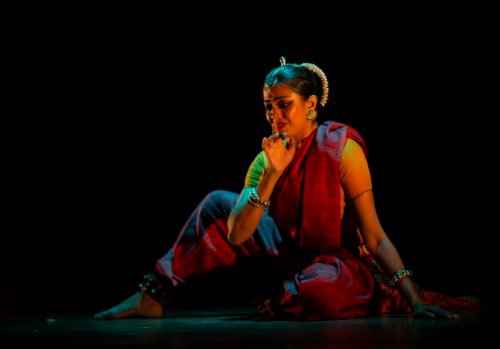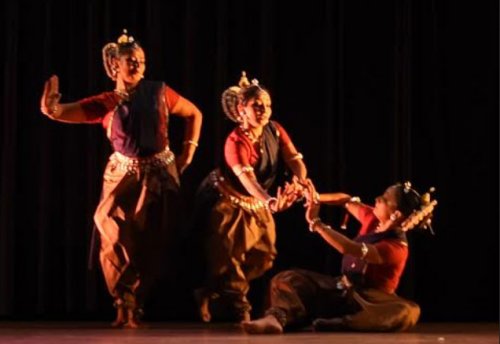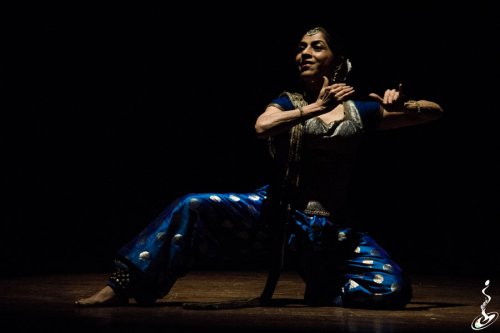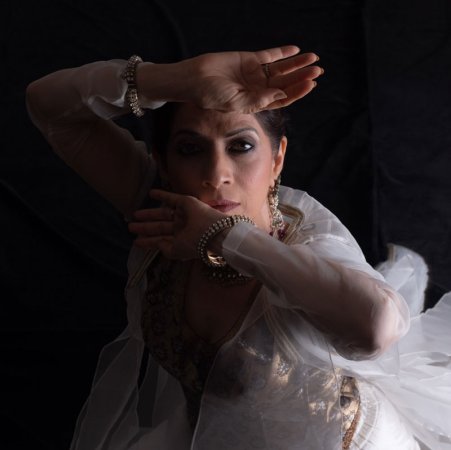
|   |

|   |
 e-mail: ukb7@rediffmail.com From Novelty to Eternity November 13, 2019 Sampriti 2019 Photos courtesy: Shashwati Garai Ghosh The panache with which the third generation youthful dancer Shashwati Garai Ghosh went about presenting some new concepts of the interfacing of dance and classical music revealed quite a new fašade of creativity. Trained by the notable dancer Sharmila Biswas - herself groomed by the legendary Guru Kelucharan Mohapatra -- Shashwati's assertive flamboyance in crafting new choreography, over and above what she was handed over by Sharmila, was impressive and was indicative that the heritage of Odissi dance that had hardly reached its diamond jubilee of resurrection and consolidation is in safe hands. Sampriti 2019 presented on October 31 at Kolkata by 'Angashuddhi' under the baton of Shashwati, was their annual festival, and this critic would like to highlight the especially innovative items in which a distinctive flair and novelty were noticeable. Late Guru Pankaj Charan Das - a pioneer of Odissi - contributed hugely to the growth of this form. Sthayi was an item drawn from the beautiful statues and murals of temples, and was inspired by basic techniques of the style. It gained a strong footing in the Odissi repertoire and developed the classical dance further. Choreographed by Shashwati, it was a delight to witness the statues and sculptures -- hanging from the temple cornices and awnings as reliefs or grottos - taking shape before the spectators' eyes.  Shashwati Garai Ghosh Sthiti (Stability) is a vital part of the special curriculum for dancers developed by Sharmila Biswas. Inspired by the Bandha Nritya of the Gotipuas of Odisha, it combined yoga and pure dance, and focused on improvement of posture, flexibility, balance and avoiding dance related injury. It also incorporated the fundamental techniques of chauka, tribhangi, padasthiti, bhangi and footwork, and utilized some elements of Hathayoga. Although more suited to the flexible body of boys, it was a brave attempt by the six young girls and had good potential beyond the training platform. Leela (Playfulness) was based on a lilting melody by Tagore for dance by youngsters, based on a Highland rhythm he heard in the UK during his sojourn. Come ye, my comrades, let's hold hands and prance round and round... went the song, and showed great promise in choreography even for the beginners. Juda Bandhinu was another beautiful composition by Sharmila Biswas, based on shringara (adornment) of their body and limbs by the Devadasis of Jagannath temple in Puri. It depicted the complete art of bodily decoration, called aharya (traditional attire) of these god's maids - Juda (coiffure), Kankan (bangles), Bali (earrings) and Vastra (outer garment) going through every detailing. Using the Sangeeta Gosain from Orissa, Shashwati's choreography seemed fascinating. Vriddhi (Growth) was the piece de resistance of the evening. Tracing the inner growth and attaining maturity of an artiste - right from her playfully learnt art lessons as a child, till the time she learns to internalize the art and further live with it and within it, the entire journey was showcased. In the first stage of childhood, she is playful and oblivious of all cares around her. The singer follows her in raga Bilawal, with basic Sargam practice. The second stage comprises her teenage years: she is occupied with friends and strives forward inspired by a collective spirit. Here, in raga Durga, the accompanying music has more complex Sargam overtures.  Shashwati Garai Ghosh's ensemble Now comes stage three: the dance practitioner is serious about the technical aspects and willing to achieve more. The raga changes to Kafi in a folk style, to permit the teenager to combine abhinaya and nritta. In the penultimate stage, the dancer is older and her body knows how and when to move; her mind is more creative and her heart wishes to give birth to the new. The raga now changes to Anandi (or Nanda) to permit pure abhinaya combining complex Sargam with bol (mnemonics). In the final stage, she journeys inwards and invokes the rasikas to walk with her in a Padavali in raga Kalashree (Kalavati plus Shuddha Re) invoking Krishna's persona in a totality of abhinaya and nritta. The concept was most admirably developed by the musician Sucheta Ganguly along with Shashwati, and came through wonderfully. Among the other items, Arpan (Dedication) was their invocation to all things pure and wholesome, with music and dance conceptualized by Shashwati. Shankarabaranam Pallavi was the group composition for basic classical Odissi, developed, elaborated and refined further with time. Here the abhinaya merged with dance, art took a more wholesome form of expression, and the fluidity and dynamic movements, and the change in rhythm from the lyrical to the forceful was magical. Immersed Krishna's character, as depicted in the Indian epic Mahabharata, is literally speaking, "a riddle, wrapped by mystery, immersed in enigma." The whirlwind of events surrounding his persona is so complex that many a scholar quite sincerely believes that there are really two Krishnas - one as the friend of Arjuna, the charioteer in the Kurukshetra battle and the great narrator of Gita in Srimad Bhagavatam. The other Krishna is the pastoral god whose legends of childhood pranks and dalliances with Radha are so endearingly described in the Harivamsa. The two were amalgamated as one Krishna, much later in the Puranic period.  Photo: AAI The celebrated Kathak dancer Aditi Mangaldas - groomed by the iconic gurus Pt. Birju Maharaj and Kumudini Lakhia -- whose prowess in breaking the barriers of convention and pushing her classical form to ever new heights of imagination, has now become the stuff of a legend. Immersed presented by her on November 1 - under the banner of Vikram Iyengar's Pickle Factory, Season 2 -- starts at this point of wonderment: who is the real Krishna? Is he the all-powerful Supreme Being of which we are always in awe, or, is he the very personal, very close compatriot of the dancer whom she always cherishes in her innermost heart? Here is how Aditi describes her preoccupation, "Krishna is one of the most beloved and interesting gods in the Hindu pantheon. Literature, architecture, dance, music, poetry and sculpture: visions of Krishna are everywhere! Can one make Krishna into a belief or a concept? Can one hold Krishna as something fixed and static? Can Krishna be of any gender, class or faith? To me, Krishna is the ever flowing river, the unquenchable flame, LIFE itself." In her solo performance, she begins the first segment with the anguished expression, through her questioning lyric: "Krishna, Achyuta, Manohar, Muralidhar, Vasudev, Anant! ... Krishna, can you be all this and more? Who thought of you, Krishna? Whose imagination are you? Is imagination greater than you?" Her tukras follow in breakneck speed and she inflames the stage with breathtaking chakkars of 3 or 6 or even 9 rounds. In near cinematic technique, the lights are "dissolved" to the second segment. Her dance is more reassured with the lyric: "Chakradhari, Giridhari, Achal, Anirudha, Keshava, Gopinath! You are immeasurable, greater than any man, woman or even God!" She observes with fascination: "Aage Krishna, Pichhe Krishna, Itthe Krishna, Utthe Krishna..." Her dance is more poised now, with many chakradhars and stand-up laykaris, followed by several engaging sawal-jawabs with tabla and pakhawaj. With another fade-out and fade-in of lights, she reaches the third and final segment which is set as a complete shadow play. The lyrical song takes off resonantly: "Parabrahma, Parthasarathi, Achal, Vishwakarma, Niranjan! You are breath, always be at the edge of my being! You are the journey; lead me through the vagaries of time! You are passion and abandon, let me partake of all that you offer! You are death, embrace me! You are LIFE, engulf me!" The choreography rises to a crescendo, with the dancer coming out of the cyclorama shadows, quizzing the eternal god with her flailing arms thrown heavenwards and her abundant gestures seeking assurance.  Photo: Dinesh Khanna The vocal compositions were by the renowned duo, Shubha Mudgal and Aneesh Pradhan (based, among others, on the sung literature Sanvare Chhaila re... by Bhartendu Harishchandra, and Aage Krishna... from Chheetswami). A high quality of research was done by Shubha Mudgal, Aneesh Pradhan and Aditi herself. The musicians were: tabla and padhant by Mohit Gangani, pakhawaj and padhant by Ashish Gangani, vocal with harmonium by Faraz Ahmed, and flute by Ravinder Rajput. The zoning of lights was of a superior quality by the light designer Fabiana Piccioli, adapted and executed by Narayan Chauhan. So was sound by the sound engineer Yogesh Dhawan. That she is immersed in the eternal Krishna came through with great conviction and her impact was total on the audience.  Dr. Utpal K Banerjee is a scholar-commentator on performing arts over last four decades. He has authored 23 books on Indian art and culture, and 10 on Tagore studies. He served IGNCA as National Project Director, was a Tagore Research Scholar and is recipient of Padma Shri. Post your comments Please provide your name and email id when you use the Anonymous profile in the blog to post a comment. All appropriate comments posted with name and email id in the blog will also be featured in the site. |